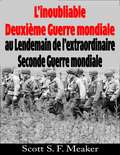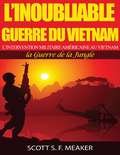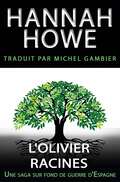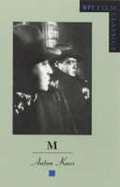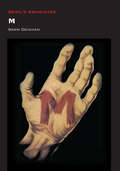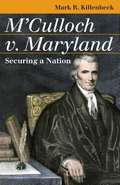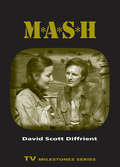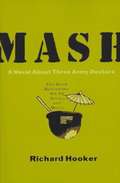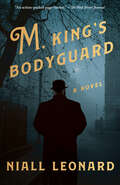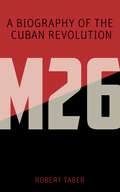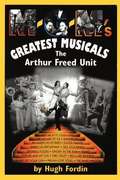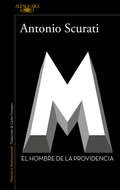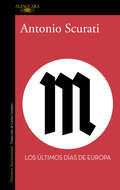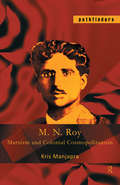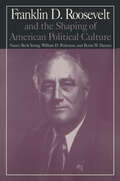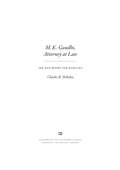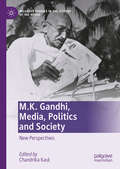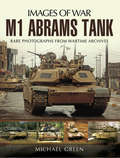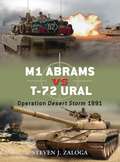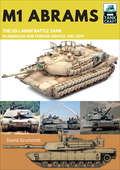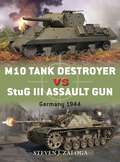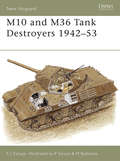- Table View
- List View
L’inoubliable Deuxième Guerre mondiale: au Lendemain de l’extraordinaire Seconde Guerre mondiale
by Hanène Baatout Scott S. F. Meaker*** Ceci est un petit ouvrage qui se focalise sur le lendemain de l'extraordinaire Seconde Guerre mondiale *** La guerre a la tradition de changer la carte sociale et économique d'un pays. Le concept de famille a été complètement déchiré avec la dévastation généralisée de la Seconde Guerre mondiale. Ce livre se penche sur les expériences de six personnes provenant de divers secteurs impliqués dans ce conflit mondial - à la suite de l'extraordinaire Seconde Guerre mondiale.
L’inoubliable Guerre du Vietnam: l’Intervention militaire américaine au Vietnam – la Guerre de la Jungle
by Hanène Baatout Scott S. F. MeakerNote: ***** Ceci est un petit ouvrage portant sur la guerre du Vietnam. ***** La guerre du Vietnam a été menée comme une guerre et elle s'est terminée avec chacune des deux parties croyant être les vainqueurs. Mais cette guerre n'a pas commencé avec une déclaration de guerre officielle. Le nombre de luttes pour le pouvoir qui font partie de la toile vietnamienne est presque écrasant. Les batailles étaient courtes et intenses et ont été menées dans la jungle et les rizières. Une grande partie de la guerre a impliqué des attaques de guérilla.
L’olivier: Racines (L’olivier #1)
by Hannah HoweL’olivier, une saga sur fond de guerre civile espagnole Se déroulant entre avril 1937 et décembre 1938, L’olivier est une mini-série de cinq mini-romans basée sur des événements réels. Les cinq tomes — Racines, Branches, Feuilles, Fruit et Fleurs — retracent les vies d’Heini Hopkins, une jeune infirmière d’un coin misérable du sud du Pays de Galles, et de Naomi Parker, une riche écrivaine issue d’un milieu privilégié. Dans le premier tome, Racines, Heini est chez elle, au Pays de Galles, où elle s’occupe de sa mère malade, tandis que Naomi assiste à des soirées de lancement de son dernier roman. La guerre civile espagnole semble a des années-lumière, jusqu’à ce que les fascistes rasent Guernica en la bombardant, massacrant des centaines d’hommes, de femmes et d’enfants. Le petit copain d’Heini, Deiniol Price, un mineur, se demande s’il n’est pas de son devoir de rallier la cause des républicains espagnols et de se porter volontaire auprès des Brigades internationales tandis que l’amant de Naomi, le prince Nicolas Esteban, un pilote, rêve de gloire en combattant pour les fascistes. Nos deux femmes devraient-elles quitter la tranquillité du Pays de Galles pour les champs de bataille sanglants de l’Espagne ? Et si elles se décidaient à suivre leurs hommes, qu’est-ce que le destin leur réserve ?
M (BFI Film Classics)
by Anton KaesThis text reconnects M to its significance as an event in 1931 Germany, recapturing the film's extraordinary social and symbolic energy. Interweaving close reading with cultural history, Anton Kaes reconstitutes M as a modernist artwork. He also analyzes Joseph Losey's 1951 film noir remake.
M (Devil's Advocates)
by Samm DeighanFritz Lang’s first sound feature, M (1931), is one of the earliest serial killer films in cinema history and laid the foundation for future horror movies and thrillers, particularly those with a disturbed killer as protagonist. Peter Lorre’s child killer, Hans Beckert, is presented as monstrous, yet sympathetic, building on themes presented in the earlier German Expressionist horror films like The Cabinet of Dr. Caligari and The Hands of Orlac. Lang eerily foreshadowed the rising fascist horrors in German society, and transforms his cinematic Berlin into a place of urban terror and paranoia. Samm Deighan explores the way Lang uses horror and thriller tropes in M, particularly in terms of how it functions as a bridge between German Expressionism and Hollywood’s growing fixation on sympathetic killers in the ‘40s. The book also examines how Lang made use of developments within in forensic science and the criminal justice system to portray a somewhat realistic serial killer on screen for the first time, at once capturing how society in the ‘30s and ‘40s viewed such individuals and their crimes and shaping how they would be portrayed on screen in the horror films to come.
M'Culloch v. Maryland: Securing a Nation (Landmark Law Cases & American Society Series)
by Mark R. KillenbeckFederalism--including its meanings and limits--remains one of the most contested principles in constitutional law. To fully understand its importance, we must turn to a landmark decision nearly two centuries old. M'Culloch v. Maryland (1819) is widely regarded as the Supreme Court's most important and influential decision-one that essentially defined the nature and scope of federal authority and its relationship to the states. Mark Killenbeck's sharply insightful study helps us understand why. Killenbeck recounts how the cashier of the Baltimore branch of the Second Bank of the United States refused to pay Maryland's tax on the bank and how that act precipitated a showdown in the Supreme Court, which addressed two questions: whether the U.S. Congress had the authority to establish a national bank and whether Maryland's tax on the bank was barred by the Constitution. In one of Chief Justice John Marshall's most famous opinions, the Court unanimously answered yes to both, authorizing the federal government to exercise powers not expressly articulated in the Constitution--and setting an alarming precedent for states--rights advocates.
M*A*S*H
by David Scott DiffrientExamines the origins, cultural significance, and legacy of the groundbreaking CBS television series M*A*S*H, which aired from 1972 to 1983.
M*A*S*H: A Novel About Three Army Doctors
by Richard HookerBefore there were the movie and the television series, there was the novel that gave birth to such American immortals as Hawkeye and Trapper John, Hot Lips Houlihan, Frank Burns, Radar O'Reilly, and the rest of the 4077th MASH--a place like no place else in Korea or on earth. The doctors and nurses who worked in the Mobile Army Surgical Hospitals (MASH) during the Korean War were well trained, dedicated, and pushed to the brink. And they were young--too young to be doing what they had to do. As Richard Hooker writes in the Foreword, "A few flipped their lids, but most of them just raised hell, in a variety of ways and degrees." Meet the true-life heroes and lunatics who fought in the Korean War, and experience the martini-laced mornings, marathon hijinks, sexual escapades, and that perfectly corrupt football game that every fan of the movie will remember. It's also a story of hard work and skill in the face of enormous pressure and odds. Here is where it all began--the novel that made M *A *S *H a legend.
M, King's Bodyguard: A Novel
by Niall LeonardA gripping, atmospheric thriller based on a true story about anarchy and assassination in Edwardian London, and one detective&’s mission to preserve the life of his king and prevent a bloody war in Europe From humble beginnings in Ireland, William Melville has risen through hard work, intelligence, and occasional brute force to become head of Scotland Yard&’s Special Branch, personal bodyguard to Queen Victoria and her family, and the scourge of anarchists at home and abroad. But when the aged Queen dies in January 1901 and the crowned heads of Europe converge on London for her funeral, Melville learns of a conspiracy, led by a mysterious nihilist known only as Akushku, to assassinate Kaiser Wilhelm of Germany at the ceremony. Racing to prevent the atrocity, Melville and his German counterpart Gustav Steinhauer find themselves tangled in a web of adultery, betrayal, and violence. As the funeral looms ever closer, Melville realizes that Akushku is the most resourceful and vicious foe he has yet encountered—but is the greater threat from Melville&’s enemies, or his allies?
M-26: A Biography of the Cuban Revolution
by Robert TaberM-26: A Biography of the Cuban Revolution, first published in 1961, is a reporter’s account of the overthrow of the Batista regime and Fidel Castro’s successful rise to power. Author Robert Taber, a correspondent for CBS, details the political and economic situation which helped foster the revolution, plus chronicles events of the revolution and his experiences while living with the guerrilla fighters in Cuba’s mountainous interior. M26 (the name is from an earlier unsuccessful uprising—Movimiento Revolucionario—led by Castro in July, 1953) is a valuable resource for anyone seeking a well-written account of this critical period in Cuba’s history.
M-G-M's Greatest Musicals: The Arthur Freed Unit
by Hugh FordinEach chapter is full of interesting facts and insightful comments about how each movie musical in the Arthur Freed unit was filmed.
M. El hombre de la providencia
by Antonio ScuratiTras M. El hijo del siglo (Premio Strega 2019, uno de los libros del año para Babelia y elogiado por Roberto Saviano como «una obra maestra»), llega la segunda entrega del gran proyecto literario de nuestro tiempo «La mejor vacuna narrativa de la que disponemos contra el populismo.»Sette – Corriere della Sera En 1925, una figura de camisa negra y gesto arrogante comienza a ocupar todos los intersticios de la vida pública italiana. Benito Mussolini, una vez que se ha convertido en el presidente del Consejo más joven de la historia de Italia, se prepara para el siguiente paso del proyecto fascista: fundir su nombre con el de su propio país. Pero la senda del autoritarismo no es sencilla: luchas internas en el partido, durísimas batallas parlamentarias, la amenaza revolucionaria, la necesidad de expandirse territorialmente, una turbulenta vida personal y palaciega, intentos de asesinato y la nueva relación con un joven Herr Hitler, cada vez más popular. Todo para que Mussolini, fascismo e Italia sean uno. Este proceso irá tomando cuerpo hasta que, en 1932, se cumpla una década de la marcha sobre Roma. Pero no hay tiempo para mirar atrás, el futuro parece encerrar una promesa brillante para el fascismo. La crítica ha dicho...«Un viaje literario que nos afecta y concierne a todos.»Corriere della Sera «Una travesía literaria inconmensurable y sin precedentes.»La Stampa «Este fresco de Scurati presenta a los protagonistas de la historia en su dimensión privada, revelando sus vicios y debilidades es un escrutinio sin escrúpulos.»Il Fatto Quotidiano Sobre M. El hijo del siglo:«Se esperaba desde hace décadas. Una obra maestra.»Roberto Saviano «Una de las novelas del año.»Ignacio Martínez de Pisón «Si este año solo vas a leer un libro, que sea este.»Matías Vallés, Diario de Mallorca - La Almudaina «Una novela [de] incontestables conquistas literarias [...]. Scurati revisa la historia. Como Yourcenar, Gore Vidal, Sebald, Echenoz o Cercas. [...] Al partisano y narrador Italo Calvino le hubiese encantado.»El País «Un perfecto equilibrio entre investigación histórica e introspección psicológica. [...] Aconsejo leer M como una distopía. Lo que nos narra pertenece al ayer, pero podría escribir el mañana.»Rafael Narbona, El Cultural de El Mundo «Este libro hay que escalarlo. Tiene esa mezcla de literatura e historia que tanto nos gusta: la elegancia de Éric Vuillard y la extensión y el arrojo de Galdós.»Sergio del Molino «Aquí queda revelado el ADN del fascismo.»La Repubblica «Una lección de historia antifascista en forma de novela.»The New York Time
M. Los últimos días de Europa
by Antonio ScuratiLOS ÚLTIMOS DÍAS DE EUROPA EL PRINCIPIO DEL FIN: HITLER, LAS LEYES RACIALES, LA GUERRA.LA GRAN NOVELA DE NUESTRO TIEMPO LLEGA A SUS AÑOS CRUCIALES Más de medio millón de ejemplares vendidos de los dos primeros volúmenes, publicados en 40 países «Scurati revisa la historia. Como Yourcenar, Gore Vidal, Sebald, Echenoz o Cercas».Javier Aparicio Maydeu, El País Con febril precisión, Antonio Scurati continúa su «novela total» reconstruyendo el delirio de un Mussolini ilusionado con poder influir en las decisiones del Führer, más solo que nunca y por fin consciente de la debilidad italiana cuando declara que ha llegado «la hora de las decisiones irrevocables». Acabada la guerra civil española, el continente se hunde en un nuevo conflicto internacional apenas veinte años después del fin del anterior. Estos son los últimos días de Europa: la culminación del autoengaño de una Italia fascista doblegada ante la infamia de las leyes raciales y el pacto con la Alemania nazi. La crítica ha dicho:«Lo que nos narra pertenece al ayer, pero podría escribir el mañana».Rafael Narbona, El Cultural «Formidable e impresionante. [...] Un ejemplo brillante del poder de la literatura y de la capacidad para articular el tiempo histórico y el tiempo humano».Le Monde«En la gigantesca reconstrucción que Antonio Scurati está haciendo de Mussolini y de su régimen, este volumen me ha parecido el más apasionante. [...] Su doble registro [...] le da a la lectura una intensidad inaudita».Corrado Augias, Il Venerdì di Repubblica «Me han gustado muchísimo las novelas de Antonio Scurati sobre Mussolini».Pierre Lemaitre «Una lección histórica de antifascismo disfrazada de novela».The New York Times«M inventa un género literario nuevo capaz de hacer que la historia sea tan palpitante como la intriga de una novela. [...] Una de las empresas literarias más fascinantes y ambiciosas de las últimas décadas».Enzo Traverso, La Lettura «Una narración capaz de comunicar algo de la experiencia caótica que es la historia».Orlando Figes, autor de Los europeos «Aquí queda revelado el ADN del fascismo».La Repubblica «Scurati está escribiendo una novela de miedo».Domingo Ródenas de Moya, El Periódico «Tras narrar el ascenso de Mussolini con M1 y los años del régimen con M2, Scurati aborda ahora el corazón de las tinieblas de la Italia fascista».Luca Mastrantonio, Corriere della Sera
M. N. Roy: Marxism and Colonial Cosmopolitanism (Pathfinders Ser.)
by Kris ManjapraThis is a work of South Asian intellectual history written from a transnational perspective and based on the life and work of M.N. Roy, one of India’s most formidable Marxist intellectuals. Swadeshi revolutionary, co-founder of the Mexican Communist Party, member of the Communist International Presidium, and a major force in the rise of Indian communism, M.N. Roy was a colonial cosmopolitan icon of the interwar years. Exploring the intellectual production of this important thinker, this book traces the historical context of his ideas from 19th-century Bengal to Weimar Germany, through the tumultuous period of world politics in the 1930s and 1940s, and on to post-Independence India. In this book the author makes a number of valuable theoretical contributions. He argues for the importance of conceiving the ‘deterritorial’ zones of thought and action through which Indian anti-colonial political thought operated, and advances a new periodisation for Swadeshi on this basis. He also argues against viewing ‘international communism’ of the 1920s as a single monolith by highlighting the fractures and contestations that influenced colonial politics worldwide.A fresh and insightful perspective on the history of India in the interwar years, this book will be of great interest to scholars and students of the modern history of South and East Asia, America and Europe, and to those interested in anti-colonial struggles, Communist politics and trajectories of Marxist thought in the 20th century.
M.E.Sharpe Library of Franklin D.Roosevelt Studies: v. 1: Franklin D.Roosevelt and the Shaping of American Political Culture
by Nancy Beck YoungHow did Americans respond to the economic catastrophe of 1929? In what ways did the social and cultural responses of the American people inform the politics of the period? How did changes in political beliefs alter cultural activities? This volume examines the presidency of FDR through a very distinctive set of lenses: the representation of FDR in film and popular culture, discussions of New Deal art and art policy, the social and political meanings of public architecture, 1930s music, and many more.
M.I.A.: Accounting for the Missing in Southeast Asia
by Paul D. MatherAmong the numerous analyses of those missing in action in Southeast Asia, this study is the first to concentrate on the process whereby the US military tried to resolve each case. Much of the continuing controversy ignores or refuses to accept the fact that the US Government, through the Joint Casualty Resolution Center and other mechanisms, has made a thorough, sustained, good faith effort to determine the fate of every serviceman declared missing in action in that conflict. The author, who spent more than 15 years in Southeast Asia taking part in those endeavors, tells the story of this unique effort from the point of view of an informed insider.A member of the MIA search team from the early 1970s through the late 1980s, Paul Mather is well qualified to relate the history of this effort. He covers a wide range of topics, from field work at crash sites and personal interchanges with Vietnamese, Cambodian, Lao, and Thai officials, through the various international accords that governed the activities of the US investigatory teams. Although political changes in the United States alternately facilitated or hampered search efforts, the attempt to resolve every case never ceased. Colonel Mather faithfully records the efforts of individuals and organizations that played major roles in. this drama: congressional committees; the National League of Families; private citizens who made sincere efforts to help; senior government officials like General John Vessey, who headed a special full-accounting commission; military agencies such as the Joint Casualty Resolution Center and the Army’s Central Identification Laboratory; scoundrels and swindlers who exploited the tragedy for personal gain; and self-styled Rambos who acted on their own.This account should help to wrap up an especially emotional chapter of the Vietnam War. By telling how the process worked for almost two decades, it contributes to the full accounting desired by all.
M.K. Gandhi, Attorney at Law
by Charles R. DisalvoIn 1888, at the age of eighteen, Mohandas Gandhi sets out from his modest home in India. Shy, timid, and soft-spoken, he embarks on what he believes will be a new life abroad. Twenty-seven years later, at the age of forty-five, he returns--this time fearless, impassioned, and ready to lead his country to freedom. What transformed him? The law. M. K. Gandhi, Attorney at Law is the first biography of the Mahatma's early years as a lawyer. It follows Gandhi as he embarks on a personal journey of self-discovery: from his education in Britain, through the failure of his first law practice in India, to his eventual migration to South Africa. Though he found initial success representing wealthy Indian merchants, events on the ground would come to change him. Relentless attacks by the white colonial establishment on Indian civil rights prompted Gandhi to give up his lucrative business in favor of representing the oppressed in court. Gandhi had originally hoped that the South African legal system could be relied upon for justice. But when the courts failed to respond, he had no choice but to shift tactics, developing what would ultimately become his lasting legacy--the philosophy and practice of nonviolent civil disobedience. As he took on the most powerful governmental, economic, and political forces of his day, Gandhi transformed himself from a modest civil rights lawyer into a tireless freedom fighter. Relying on never-before-seen archival materials, this book provides the reader with a front-row seat to the dramatic events that would alter Gandhi--and history--forever.
M.K. Gandhi, Media, Politics and Society: New Perspectives (Palgrave Studies in the History of the Media)
by Chandrika KaulThis Palgrave Pivot showcases new research on M.K. Gandhi or Mahatma Gandhi, and the press, telegraphs, broadcasting and popular culture. Despite Gandhi being the subject of numerous books over the past century, there are few that put media centre stage. This edited collection explores both Gandhi’s own approach to the press, but also how different advocacy groups and the media, within India and overseas, engaged with Gandhi, his ideology and methodology, to further their own causes. The timeframe of the book extends from the late nineteenth century up to the present, and the case studies draw inspiration from a number of disciplinary approaches.
M1 Abrams Tank (Images of War)
by Michael GreenThis pictorial history of the legendary M1 Abrams Tank illustrates its versatility and advancement from the Cold War Era to the present day. The M1 Abrams has proved itself to be the finest main battle tank in the world since its introduction into US Army service in 1981. It combines the ultimate balance between firepower, mobility and protection as demonstrated by its superior performance during the two Gulf Wars and in Afghanistan. It routed the Soviet equipment of Saddam Hussein's army and today remains the yardstick by which friends' and foes' MBTs are judged. As military expert Michael Green demonstrates in this illustrated history, the M1&’s versatility, and its continual modernization of weaponry armor and engineering, guarantees that it will remain the US Army's spearpoint for years to come. With its comprehensive collection of images and authoritative text, this volume is an ideal resource for information on M1 Abrams Tank design and combat operations.
M1 Abrams vs T-72 Ural: Operation Desert Storm 1991
by Steven J. Zaloga Jim LaurierThe Gulf War bore witness to a number of deadly encounters between these two great adversaries. Heavily armored, highly mobile and capable of killing at over 2500m the M1 Abrams is, to this day, a veritable fighting machine. Superior to both Iraq's Soviet era T-55 and T-62 tanks, nearly all sources claim that no Abrams tank has ever been destroyed by enemy fire. Despite entering service in 1980, the M1 Abrams remained untested in combat until the Gulf War in 1991, where it was to be confronted by its archenemy the Iraqi-assembled Soviet-designed T-72. Entering production in 1971, the T-72 arguably outstripped its contemporaries in a balance of mobility, protection and firepower. By the time of Operation Desert Storm, however, the tables had turned and the tank suffered due to low quality ammunition and poorly trained crews. In this fascinating study, Steven Zaloga pits these two great fighting machines against one another, plotting the development of the Cold War until both tanks met in combat in the deserts of Iraq and Kuwait. From the Trade Paperback edition.
M1 Abrams: Rare Photographs From Wartime Archives (Images of War)
by David DoyleA photographic history of the principal main battle tank of the modern US military. Conceived to counter the threat of a massive Soviet armored incursion in Europe, the M1 Abrams tank gained considerable fame during the Persian Gulf War of 1991, and its combat record has continued to climb. With such a long service life, the Abrams has undergone continual improvements and upgrades, which are illustrated in great detail in this volume. The unique features of the various models are detailed in stunning color photos, and the combat use of these fearsome vehicles is richly illustrated through previously unpublished photos. The story of the Abrams begins in the late 1960s when the threat of Soviet Armor developments forced the U.S. to look for a suitable replacement for the M60 series. A joint venture between the U.S. and West Germany to build a suitable common Main Battle Tank brought about the unorthodox and terribly expensive MBT70. It never saw series production. When this program was cancelled in 1970, a quest for a more cost-effective tank was begun. The constant development, upgrade, and conversion of the series have kept the Abrams at the forefront of main battle tank technology—and it has proven itself on the battlefield time and time again. This book, filled with rare archival photos, takes us through decades of its remarkable history, including improvements to its armor, transmission, and engine; the addition of an integrated nuclear, biological, and chemical system; the installation of a layer of depleted uranium and interior blast doors to protect the crew, and more.
M1 Abrams: The US's Main Battle Tank in American and Foreign Service, 1981–2019 (Tank Craft)
by David GrummittA history of the iconic vehicle: &“This modeler's delight showcases the M1 and its variations with all sorts of camouflage schemes.&” —Historical Miniatures Gaming Society Since its introduction in 1981, at the height of the Cold War, the Abrams main battle tank has been one of the most visible symbols of American military power, and it is the fascinating subject of this heavily illustrated historical and modeling guide in the TankCraft series by David Grummitt. Designed to meet head-on the massed tank forces of the Warsaw Pact, its combat debut actually came in a different scenario in 1991, during the First Gulf War. Since then it has served in a peacekeeping role in the former Yugoslavia and seen combat in Iraq, Afghanistan, and Yemen. It has gone through a series of modifications and modernizations that see it set to remain the backbone of the US Army until at least 2050. As well as charting the development and combat history of the vehicle, this book is illustrated throughout with color photos and specially commissioned color profiles. Five different models, covering the service history of the Abrams, are featured, as is a modeler&’s guide to the existing kits and accessories in the all the popular scales.
M1 Abrams: The US's Main Battle Tank in American and Foreign Service, 1981–2019 (Tank Craft)
by David GrummittA history of the iconic vehicle: &“This modeler's delight showcases the M1 and its variations with all sorts of camouflage schemes.&” —Historical Miniatures Gaming Society Since its introduction in 1981, at the height of the Cold War, the Abrams main battle tank has been one of the most visible symbols of American military power, and it is the fascinating subject of this heavily illustrated historical and modeling guide in the TankCraft series by David Grummitt. Designed to meet head-on the massed tank forces of the Warsaw Pact, its combat debut actually came in a different scenario in 1991, during the First Gulf War. Since then it has served in a peacekeeping role in the former Yugoslavia and seen combat in Iraq, Afghanistan, and Yemen. It has gone through a series of modifications and modernizations that see it set to remain the backbone of the US Army until at least 2050. As well as charting the development and combat history of the vehicle, this book is illustrated throughout with color photos and specially commissioned color profiles. Five different models, covering the service history of the Abrams, are featured, as is a modeler&’s guide to the existing kits and accessories in the all the popular scales.
M10 Tank Destroyer vs StuG III Assault Gun
by Steven Zaloga Richard ChasemoreAlthough tanks like the Sherman and Panther captured the headlines, the Allies' M10 tank destroyer and the Germans' Sturmgeschütz (StuG) III were the unsung workhorses of the northwest European battlefields of 1944-45. While their mission was not principally fighting one another, their widespread use ensured their frequent encounters, from the Normandy bocage to the rubble-strewn streets of Aachen. The StuG III was the quintessential assault gun: a low-slung, heavily armored, turretless vehicle intended to provide direct-fire support for infantry formations. It was a jack of all trades, being used both for the traditional direct-fire role, but also increasingly for antitank defense; when its armament was improved from a short 75mm gun to the better-known long 75mm gun, it reached its pinnacle and remained largely unchanged from 1943 to 1945. It proved exceptionally valuable in Normandy as its low profile and excellent armament made it a useful infantry support weapon while at the same time it had more than adequate firepower to destroy standard Allied tanks such as the Sherman.The M10 3in Gun Motor Carriage was originally developed as a tank destroyer. It was based on the Sherman tank chassis but with less armor and a more powerful gun. By 1944, however, its 3in gun proved ineffectual against the most thickly armored German tanks such as the Panther and Tiger. As a result, by 1944, the US Army's M10 battalions were usually deployed in support of US infantry divisions to conduct direct-fire support. Essentially, the M10 became the US Army's principal assault gun in the 1944-45 ETO campaign, whether intended for this role or not.Widely deployed in roles their designers had not envisaged, these two armored fighting vehicles clashed repeatedly during the 11-month campaign that saw the Allies advance from Normandy to the heart of the Reich. Fully illustrated with specially commissioned artwork, this is the story of their confrontation at the height of World War II.
M10 and M36 Tank Destroyers 1942-53
by Steven Zaloga Peter SarsonThe US Army had a unique tactical doctrine during World War II, placing the emphasis for tank fighting on its Tank Destroyer Command whose main early-war vehicle was the M10 3-inch Gun Motor Carriage, based on the reliable M4A2 Sherman tank chassis. This durable and versatile vehicle saw combat service from the North Africa campaign in 1943. By 1944, its gun was not powerful enough and it was rearmed with the new 90 mm gun, becoming the M36 90mm Gun Motor Carriage. This book details one of the only US armoured vehicles capable of dealing with the Panther and Tiger during the Battle of the Bulge.
